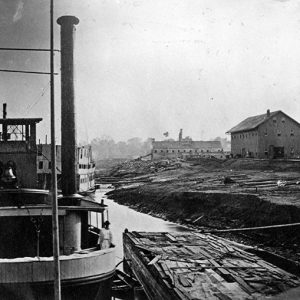calsfoundation@cals.org
USS Tensas
aka: Tom Sugg [Steamboat]
The USS Tensas was originally the steamboat Tom Sugg, which was captured by Federal troops during the Little Rock Campaign of 1863 and refitted as a tinclad gunboat before again returning to private service in 1865.
The Tom Sugg was a sixty-two-ton sidewheel paddleboat built at Cincinnati, Ohio, in 1860. The vessel was ninety-one feet and eight inches long and twenty-two feet and five inches wide. By 1862, the steamboat was being used by Confederate forces in Arkansas, and in the spring of 1862, Captain John W. Dunnington “armored” it with cotton bales and mounted an 8-inch cannon on its bow so that it could be used against Major General Samuel R. Curtis’s Army of the Southwest. While there are no reports that the Tom Sugg saw action during this period, it continued to serve the Confederacy on the White and Little Red rivers.
The Tom Sugg was at Clarendon (Monroe County) when Brigadier General John Wynn Davidson’s cavalry division approached the White River town during the 1863 Little Rock Campaign. The Federals arrived at Clarendon on August 9 and were joined two days later by a small U.S. Navy flotilla under Lieutenant George M. Bache. On August 12, Bache, bolstered by part of a battalion of the Thirty-Second Iowa Infantry, steamed up the White River intent on capturing the Tom Sugg and Kaskaskia, the last two Confederate steamboats operating on the White. The USS Cricket under acting volunteer lieutenant A. R. Langthorne separated from the gunboats Lexington and Marmora at the Little Red River, steaming up that river in pursuit of the steamboats while the other warships continued up the White toward Augusta (Woodruff County).
The Cricket caught up with the Confederate steamboats at Searcy (White County) and placed prize crews aboard after creating makeshift breastworks on the boats from seized cotton bales. The three vessels were heading back downstream when they were attacked at West Point (White County) by part of Brigadier General Joseph O. Shelby’s Iron Brigade. After a sharp firefight, the vessels fought their way through and returned to Clarendon. Bache declared that “the Tom Sugg is a fine little side-wheel boat, and I think would make an excellent light-draft gunboat for these waters.” On August 16, Bache armed the Tom Sugg with a 12-pounder rifled howitzer, and the steamboat helped transport supplies, men, and horses as Major General Frederick Steele’s infantry division crossed the White during its approach toward Little Rock (Pulaski County).
The Tom Sugg was taken to the U.S. naval base at Cairo, Illinois, and the navy purchased it from an Illinois prize court for $7,000 on September 29, 1863. At the urging of Rear Admiral David Dixon Porter, who said that the steamboat was “an excellent vessel, and will make one of our most useful gunboats,” the Tom Sugg’s name was changed to Tensas. Converted to a tinclad gunboat and armed with a pair of 24-pounder howitzers, the USS Tensas was commissioned at Mound City, Illinois, on January 1, 1865, under Acting Master E. C. Van Pelt and served on the Mississippi River for the remainder of the war.
It was decommissioned on August 7, 1865, and sold at public auction for $6,200 to E. B. Trinidad of New Iberia, Louisiana, who renamed it the Teche. The vessel was sold to the Atakapas Mail Transportation Company and was wrecked in Bayou Teche in 1868.
For additional information:
Christ, Mark K. Civil War Arkansas, 1863: The Battle for a State. Norman: University of Oklahoma Press, 2010.
Edwards, John N. Shelby and His Men, or The War in the West. Cincinnati, OH: Miami, 1867.
Huddleston, Duane. “White River Steamboating During the Civil War January 1, 1862 to July 1, 1865.” The Stream of History 17 (January–April 1979): 3–42.
“Tensas.” Dictionary of American Fighting Ships. https://www.history.navy.mil/research/histories/ship-histories/danfs/t/tensas.html (accessed July 13, 2018).
“Tom Sugg.” Dictionary of American Fighting Ships. https://www.hazegray.org/danfs/csn/t.txt (accessed July 13, 2018).
Way, Frederick, Jr., comp. Way’s Packet Directory. Athens: Ohio University Press, 1994.
Mark K. Christ
Little Rock, Arkansas
 Civil War through Reconstruction, 1861 through 1874
Civil War through Reconstruction, 1861 through 1874 Cotton Industry
Cotton Industry Military
Military Possibly the USS Tensas
Possibly the USS Tensas 




Comments
No comments on this entry yet.